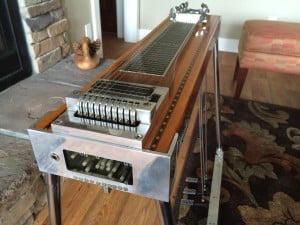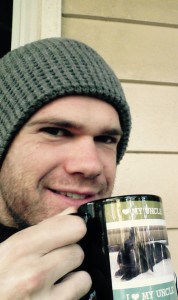In 2014, on a humid summer morning in North Carolina, I sat in my bedroom wondering if I’d ever be able to play something decent with my C6 neck. I had just gotten this new tuning/neck a few months earlier; I had been a single neck E9 player up until then, and had been playing pedal steel for about four years.
After taking a sip of black, light-roast coffee, I remembered that YouTube holds certain treasures of pedal steel past. I decided to browse for C6 learning material, and hold steady to avoid the pitfalls of viral videos. The dew of morning, mixed with YouTube search results, brought forth various videos labeled Bobbe Seymour. The name sounded familiar from the Steel Guitar Forum, and he had a smile on his face, so I decided to check the videos out (not literally like you used to check out videos from BlockBuster).
Bobbe had a lot of videos on C6, so I sipped away on my coffee, and watched most of them: with a steady eye on my C6 neck to make sure it wouldn’t bite me. I barely had any control over this C6 beast I had adopted, and had only been lightly toying around with Buddy Emmons’ Pocket Corner when playing. I could understand why players stuck with having only an E9 dog in the fight.

But Bobbe made it look easy on those videos, even assuring that the neck was more intuitive or easy than the E9 neck. That was a relief. I felt good with my playing on the E9 neck, like I could let it off the leash wherever. I had to keep it within a certain range, or it’d run away, but still.
What really caught my attention was the chords he was playing, by just raking or strumming a bunch of strings in a row, without having to make funky right hand grips. It was like a magic trick, and here was Bobbe showing me how to do it on the World Wide Web, and he was from Nashville, TN, or what seemed to me to be the Pedal Steel Capital of the World.
He was a pro, in Pedal Steel City, with some great chops in these videos I was soaking up. I watched in awe as he played a bass line with his thumb (“patting his thumb”is what he was calling it), and played a melody at the same time. It sounded folky and jazzy to me, like Leo Kottke meets Ry Cooder; I liked it. The coffee was hitting me, time to practice and take advantage of the stimulation.
I wasn’t able to let the C6 off the leash that day, but I was able to tinker with the idea, and a few of the chords Bobbe suggested. I decided I still wasn’t passionate about the C6 neck, and didn’t do much with it for awhile.
A year later I got into listening to some really soulful music, more specifically bottleneck slide cats from back in the day, a few gospel outfits from way back when, and Aretha Franklin with King Curtis. I was also researching the history of the steel guitar, and Hawaiin music at this time. A new day, a new cup of coffee in hand, I was astounded to learn of a connection between steel guitar and slide guitar in America’s history. It almost seemed like the two branched off from one another at a fork in the road of time.
What intrigued me about the slide players, besides selling their souls for better musical skills, was how they had to entertain audiences and parties with just their guitar, slide, and voice: just themselves. Slide-playing is hard enough, but playing bass notes and singing with it: man, these guys were really ahead of the game back in the 1900s. A thought popped into my head about Bobbe’s advice on patting, and using the technique to entertain with just a pedal steel, and no supporting instrumentation. Maybe pedal steel players could entertain audiences with just their pedal steel, like the slide players used to in the Delta.
I went home that day and dug out a tab for “Going to California” by Led Zeppelin, remembering how I always wished I could play it on guitar. I recalled that it had a repeating bass line, was in a somewhat open tuning, and was catchy. I wouldn’t mind practicing this for awhile.
I soon realized I’d have to make my own arrangement, to make it fit with C6 pedal steel, and add a melody part since Robert Plant wasn’t accompanying me. This was going to take some time. But I started slow, and eventually could hear the potential for decency if I stuck with it.

A few months later, I was able to get it sounding decent at a very slow speed, and was tinkering with other ideas/arrangements, like Pink Floyd’s “Goodbye Blue Sky” and “Is There Anybody Out There?”. This was sounding cool, and I was keeping in touch with my high school classic rock years. I kept the technique in mind during my practice sessions, and developed a slight independency with my middle finger from the thumb’s “patting.”
Fast forward a half year, and here we are today: stuck right in between the future and the past, again. I am so glad I stuck with Bobbe’s advice about chord patting, and playing melodies simulataneously. So I decided to record this technique today!
I recorded these in my home, at my practice area, in a little over half an hour. The audio mixing took more time, and energy. The tracks were improvised/composed on the spot. What I mean by this: I did a few takes in a certain key, playing around through some chord changes in a pocket, and by the third take it had developed into something. This third take is what you’re usually hearing; the first take I just hit record with a key/position in mind. Sometimes I get something good on the first or second takes though.
I am using my thumb and middle finger only for 95% of what you hear. I play the bass parts with my thumb, the melody with my middle finger, and use the index finger to beef up a voicing when it needs it. It’s fun playing most of this with just two fingers, who would’ve thought?

I am playing along with a click track set to 87 BPM, with no accents (1/4 time). Also, I am patting my right toes, within my right shoe on my volume pedal, along with the click track. For more about this method, read my article “Tapping Your Toes to Keep Time”. This helps me keep time with my thumb, since there is no drummer or bass player with me.
I included the click track for one of these samples, so you can hear how my bass playing w/ thumb usually lands on the quarter notes to keep a steady rhythm for the listener. That is the goal, to keep a driving pulse (thumb/bass) for the melody to sing over, when we are playing without a rhythm section or accompaniment.
I included some drone tracks too, to give some extra listening options/flavor. You can hear the potential for adding other instruments to this mix when you hear the click and drone with them.
Here are the samples of these chord-melodies:
Considering I first tried Bobbe’s thumb patting method a year ago, and practiced it a little bit over time, he was right. It isn’t as hard as it looks. Sure, it’s a work in progress, but I’m gonna keep with it and develop it over time. It’s not too shabby, for being improvised on the spot. If I can make the same gains I made this past year, next year, I’ll be a happy camper. Thanks Bobbe, these recordings are dedicated to you.
With click and drone for “Deep Forest”…
So far using this technique, I have worked out my own arrangements of these chord melodies on the C6 neck:
“Going to California” – Led Zeppelin
“Is There Anybody Out There?” – Pink Floyd
“Goobye Blue Sky” – Pink Floyd
“Sea of Love” – Jill Andrews and Langhorne Slim
“Mad World” – Gary Jules

Thanks for reading and listening, and check The Steel World for more pedal steel buzz.
You can find some of Bobbe’s videos here, and on YouTube.


